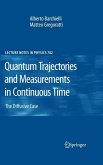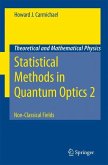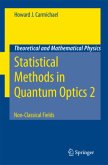This course-based monograph introduces the reader to the theory of continuous measurements in quantum mechanics and provides some benchmark applications.
The approach chosen, quantum trajectory theory, is based on the stochastic Schrödinger and master equations, which determine the evolution of the a-posteriori state of a continuously observed quantum system and give the distribution of the measurement output. The present introduction is restricted to finite-dimensional quantum systems and diffusive outputs. Two appendices introduce the tools of probability theory and quantum measurement theory which are needed for the theoretical developments in the first part of the book.
First, the basic equations of quantum trajectory theory are introduced, with all their mathematical properties, starting from the existence and uniqueness of their solutions. This makes the text also suitable for other applications of the same stochastic differential equations in different fields such as simulations of master equations or dynamical reduction theories.
In the next step the equivalence between the stochastic approach and the theory of continuous measurements is demonstrated.
To conclude the theoretical exposition, the properties of the output of the continuous measurement are analyzed in detail. This is a stochastic process with its own distribution, and the reader will learn how to compute physical quantities such as its moments and its spectrum. In particular this last concept is introduced with clear and explicit reference to the measurement process.
The two-level atom is used as the basic prototype to illustrate the theory in a concrete application. Quantum phenomena appearing in the spectrum of the fluorescence light, such as Mollow s triplet structure, squeezing of the fluorescence light, and the line width narrowing, are presented.
Last but not least, the theory of quantum continuous measurements is the natural starting point to develop a feedback control theory in continuous time for quantum systems. The two-level atom is again used to introduce and study an example of feedback based on the observed output.
The approach chosen, quantum trajectory theory, is based on the stochastic Schrödinger and master equations, which determine the evolution of the a-posteriori state of a continuously observed quantum system and give the distribution of the measurement output. The present introduction is restricted to finite-dimensional quantum systems and diffusive outputs. Two appendices introduce the tools of probability theory and quantum measurement theory which are needed for the theoretical developments in the first part of the book.
First, the basic equations of quantum trajectory theory are introduced, with all their mathematical properties, starting from the existence and uniqueness of their solutions. This makes the text also suitable for other applications of the same stochastic differential equations in different fields such as simulations of master equations or dynamical reduction theories.
In the next step the equivalence between the stochastic approach and the theory of continuous measurements is demonstrated.
To conclude the theoretical exposition, the properties of the output of the continuous measurement are analyzed in detail. This is a stochastic process with its own distribution, and the reader will learn how to compute physical quantities such as its moments and its spectrum. In particular this last concept is introduced with clear and explicit reference to the measurement process.
The two-level atom is used as the basic prototype to illustrate the theory in a concrete application. Quantum phenomena appearing in the spectrum of the fluorescence light, such as Mollow s triplet structure, squeezing of the fluorescence light, and the line width narrowing, are presented.
Last but not least, the theory of quantum continuous measurements is the natural starting point to develop a feedback control theory in continuous time for quantum systems. The two-level atom is again used to introduce and study an example of feedback based on the observed output.
From the reviews:
"This quite interesting book is devoted to the theory of continuous measurements in quantum mechanics. ... aimed at both mathematicians and physicists, keeping together mathematical rigor and physical motivation. ... The presentation ends with two very well written and useful appendixes, providing a brief and self-contained introduction to stochastic differential equations as well as the general formulation of quantum mechanics. ... these two appendixes are meant to help the physicists or the mathematicians which are not confident with the formalism or the physical interpretation, respectively." (Bassano Vacchini, Zentralblatt MATH, Vol. 1182, 2010)
"This monograph is intended principally for researchers in theoretical quantum optics and related fields. ... The book is well structured and the presentation is excellent. The mathematics is developed rigorously and without compromise: the physical interpretation is always kept to the fore. ... Anyone interested in quantum trajectory theory will find this work a most useful introduction." (Alexander C. R. Belton, Mathematical Reviews, January, 2013)
"This quite interesting book is devoted to the theory of continuous measurements in quantum mechanics. ... aimed at both mathematicians and physicists, keeping together mathematical rigor and physical motivation. ... The presentation ends with two very well written and useful appendixes, providing a brief and self-contained introduction to stochastic differential equations as well as the general formulation of quantum mechanics. ... these two appendixes are meant to help the physicists or the mathematicians which are not confident with the formalism or the physical interpretation, respectively." (Bassano Vacchini, Zentralblatt MATH, Vol. 1182, 2010)
"This monograph is intended principally for researchers in theoretical quantum optics and related fields. ... The book is well structured and the presentation is excellent. The mathematics is developed rigorously and without compromise: the physical interpretation is always kept to the fore. ... Anyone interested in quantum trajectory theory will find this work a most useful introduction." (Alexander C. R. Belton, Mathematical Reviews, January, 2013)








